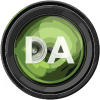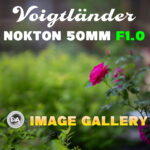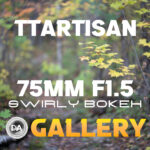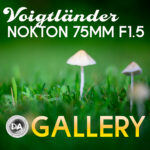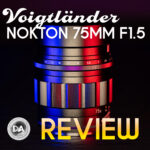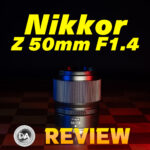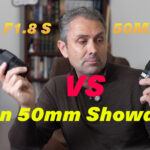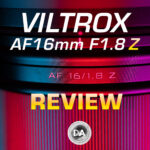
Ahhh, it is nice to be reviewing another Voigtländer lens! My last Voigtländer review was back in 2020, and it was actually a review of the APO-Lanthar 50mm F2 that a subscriber had personally loaned me because I had no access to Voigtländer products here in Canada because of their not having a Canadian distributor (at least that I was aware of) and a complication with sending their products across the border from the US. Fortunately that has all changed for the better, and early this year I received an email that I was very happy to get – a “hello” from JCL Sales Group, the distributor for Voigtländer in Canada. They wanted to know if I was interested in doing more Voigtländer reviews, to which I responded, “absolutely!”

I’ve got a bit of soft spot for Voigtländer lenses, having owned three of them and currently using one that I do own (APO-Lanthar 65mm F2 Macro) on a regular basis. That has only grown since Zeiss has seemingly transitioned away from producing non-cine camera lenses, leaving Voigtländer as the only company filling that unique niche of premium manual focus lenses. Voigtländer is actually the oldest surviving lens maker, and is a company that traces its roots to Vienna, Austria, in the mid 1700s. Like Zeiss (a German company), the more modern lenses have been produced in Japan by Cosina, and there is just something special about their optical glass that produces gorgeous colors. Today’s review is of one of their newest lenses – the Voigtländer Nokton 50mm F1.0. I’m reviewing it on Sony E-mount, and while there are similar lenses for Canon RF and Nikon Z mounts, Voigtländer says that this new lens was exclusively developed for Sony. This is the most expensive lens currently made by Voigtländer, and the reason is all about that F1.0 maximum aperture. It’s extreme in every way, and I’ve reviewed very few lenses that match the light gathering potential of the Nokton F1 (as I’ll call it for brevity here). If you want my full thoughts on this lovely new lens, you can either watch my video review below…or just keep reading.
Follow Me @ YouTube | Patreon | Instagram | Facebook | DA Merchandise | Flickr | 500px | X
__________________________________________________________________________________________________
Thanks to JCL Sales Group for sending me a review loaner of this lens. As always, this is a completely independent review. *The tests and most of the photos that I share as a part of my review cycle have been done with the Sony a7RV along with the Sony Alpha 1 that serve as my benchmark cameras for Sony lenses.
__________________________________________________________________________________________________
Voigtländer lenses follow a tried and true formula that has been true across the four different mounts that I’ve tested them on. This includes a premium build that is all metal and glass, well executed aperture and focus rings, electronic contacts to communicate EXIF data and to enable more manual focus aids, but no weather sealing. Their lenses tend to be more like classic Zeiss lenses in build but typically smaller and less extreme in size. All of this is true here, and while the Nokton 50mm isn’t a small lens, it is only moderately sized. It has that stubby profile that looks really great mounted on your camera.

There are two aspects of Voigtländer lenses that I enjoy: 1) the beautiful manual focus action and 2) the uniquely beautiful rendering and image quality. That F1.0 aperture allows for extremely shallow depth of field and a lot of lovely, creamy bokeh.

So is the new Nokton 50mm F1.0 worth the roughly $1900 USD price tag? That’s going to depend a lot on your priorities.
Build and Handling
There are essentially two different variations of the Voigtländer design language in use right now. We have a classic “knurled” style to the manual focus ring as seen on the also new Nokton 75mm F1.5 that I just reviewed (and my older APO-Lanthar 65mm F2) and then also a diamond pattern grip surface seen on the Nokton 50mm F1.0 (shown here in Sony e-Mount).

The diamond pattern grip and slightly updated design language is something new for Voigtländer, and I like it. It’s a bit more contemporary, but it looks and feels very premium, too. The word that I’m getting is that Voigtländer is going to use both styles to differentiate different mounts. All Z-mount lenses, for example, will get the scalloped look while Canon RF in particular will all have the diamond pattern. I’m not sure where that leaves Sony E-mount, as both styles currently exist there.

Sony E-mount lenses often have a taper to the mount, as the E-mount is fairly small relative to Canon RF and, in particular, Nikon Z mounts. The biggest problem with this is illustrated above, as Sony uses the smaller mount as a reason to make their cameras smaller and narrower than competitors. But the problem with many lenses is that when the lens flares back out to accommodate the optical design it creates a very narrow spot right where your knuckles flex around the grip. You can see from the shot above there isn’t much room between the grip and the lens barrel. For me there is no pinch, but my knuckles do touch the lens some while gripping the camera. That’s more of a Sony problem than a Voigtländer problem, however.

That narrow section of the lens has a hyperfocal markings (from F2 to F16) and also a thin ribbed section that gives additional style and grip for mounting/unmounting the lens.
The next section is the manual focus ring. It has that diamond pattern grip that I think both looks great and also has nice feel for focus. These Voigtländer focus rings are beautifully engineered, with the perfect balance between enough resistance for precision and enough freedom for smooth, gliding focus. There is roughly 180° of focus throw (rotation), which is about perfect, in my opinion. It’s long enough to allow for precision, but not so long that you have to make multiple rotations of the wrist to make major focus changes.

Markings are etched and painted, with red for Imperial (feet) and white for metric (Meters). The inner barrel will extend about 13mm during focus (this is not an internally focusing lens), with the extension coming towards the minimum focus side (the lens is fully retracted at infinity focus).


The third ring is the aperture ring, and it is located closest to the front of the lens. The aperture ring is the first I’ve used from Voigtländer that has a declick option. When clicked, there are detents on the one-third stop aperture positions from F1 to F16.

The process to switch from clicked to declicked is a little clunky. It involves pulling the very narrow ring beyond the aperture ring back towards the camera in a clutch type action, and then rotating that section 180°. It is nearly impossible to not also rotate the aperture ring at the same time. There are two raised ridged protrusions on these rotating sections to allow you to grip this ring, as it is very difficult to grip it anywhere else.

I’m really glad for the declick option, but I think Voigtländer needs to develop a more elegant solution for the process.
The aperture iris itself has a high blade count of 12. This is appreciated, as Voigtländer works with straight blades in their apertures, so a higher blade count helps retain a more circular shape at smaller apertures, though you will still see the points of this aperture iris in some specular highlights.

Up front we have a very common 67mm front filter thread size along with some badging regarding the lens designation.

There is an included narrow lens hood that threads onto those metal filter threads (no bayonet). A threaded lens hood can’t reverse for storage, so you’ll either choose to not use the hood or leave it threaded on all the time. The short length of it doesn’t means it isn’t much of a liability to leave it attached all the time. There’s enough room in there to get a finger in to rotate a filter if you’re using one (and using filters on a lens this fast will probably be necessary at times to give you more control over shutter speed).

At the rear of the lens you fill the electronic contacts that will communicate all relevant information to the camera. That will include EXIF information, information for IBIS (camera stabilization, if so equipped), and information for various manual focus aids. The lens basically handles as normal, save that there is no autofocus nor the ability to change the aperture from within the camera.

I see no weather sealing gasket there, and no weather sealing is claimed for the lens.
The Nokton F1 is on the small side of medium in terms of size, more squat than long. It is 79.3mm (3.12″) in diameter x 69.3mm (2.73″) in length. Due to the wide diameter and solid construction the weight is a little more substantial at 590g (20.8oz). Though Sony’s cameras aren’t large, this lens is an easy fit and balances well on them.

The minimum focus distance is 45cm. That’s on the low side of average, and the Nokton F1 has a 48° angle of view, which is a little wider than the average for a 50mm lens (typically 45-46°). The resulting magnification, while not listed, looks a little lower than the average of 0.15x. I would estimate it more at 0.13x.

The magnification level clearly isn’t particularly high, but you’ll obviously be able to strongly blur out backgrounds due to the huge maximum aperture. I stopped down to F2 for this shot to keep a bit more in focus, and you can still see how beautifully blurred the background is.

All in all, the Voigtländer Nokton 75mm F1 was pretty much exactly what I expected. A very solid build with gorgeous engineering, and you do have the added functionality of being able to declick the aperture. The extreme nature of this lens optically means that the price tag is higher than the typical Voigtländer lens, but there aren’t many quality F1 lenses out there. You buy a Voigtländer lens for different reasons that you buy a Sigma, and there is nothing here that will disappoint those who love and appreciate quality manual focus lenses.
Manual Focus on Sony (Alpha 1 and a7RV)

When I first moved to Sony bodies, I found them a wonderful platform for manual focus. They had IBIS (in-body-image-stabilization), good viewfinders, and much more manual focus aids than the DSLRs that I was accustomed to. Since that point, however, essentially the whole industry has shifted to mirrorless cameras, so those advantages aren’t as distinct anymore. But I still found the Nokon F1 an easy lens to use on my Sony bodies and found that I could easily nail focus despite the huge maximum aperture and narrow depth of field. Here’s a few reasons why:
- EVF. An electronic viewfinder has a lot of advantages over an optical viewfinder when it comes to using manual focus lenses. You have the ability to see overlays, magnify the image to confirm focus, and as a byproduct I really didn’t have any misses. I don’t always love Sony’s viewfinders due to them going a bit weird when you half-depress the shutter for stabilization, but focus is still really easy due to the EVF.
- Effective IBIS (Steadyshot Inside). Sony was a pioneer with IBIS, and while other companies have caught up and even surpassed them, having the ability to stabilize the viewfinder or LCD screen image while focusing makes manual focus much easier. You can hold that image still while you pull focus to the perfect point.
- Useful manual focus aids. Sony’s options include the ability to have a color overlay to help to show what is in focus, though I will note that this works better when shooting at larger apertures and at close to medium distances. At longer distances where more is in focus, the color overlays can just become distracting, and just because a lot is in focus doesn’t yet mean that focus is where you want it. I prefer the secondary method, which is to enable an automatic magnification of the focus area whenever you turn the focus ring. This allows you to visually confirm focus is where you want it, and it is pretty foolproof. Sony’s system will both automatically magnify the focus area when you turn the focus ring and then also switch back to the full view when you go to depress the shutter so that you can ensure your composition is still what you want.
I own four different brands of camera (Sony, Canon, Nikon, and Fujifilm), and while I would say that I like Sony’s viewfinders the least in some ways, I still found manual focus with the Nokton F1 nice and easy…right down to focusing on a single blade of grass at F1.

It is worth noting that the beautiful focus ring also makes doing focus pulls during video a treat. There’s nothing quite like a well calibrated true manual focus ring for smooth pulls.
Image Quality Breakdown
The term “Nokton” in the name of this lens is a reference to “nocturnal”, and emphasizes its ability in low light due to the bright maximum aperture. The optical formula here is relatively simple, with just 9 elements in 7 groups. There are two different kinds of aspherical lenses in this design. The grinding aspherical lens stands out for having a very high refractive index.

There are some Voigtländer lenses that are exquisitely sharp at large apertures (typically the Lanthar lenses), while others like the Nokton 40mm F1.2 have more of a dual personality – a bit “dreamy” at large apertures while extremely sharp when stopped down. The Nokton 50mm F1.0 falls more into the latter category, though that’s to be expected for an F1.0 lens. Getting corner to corner sharpness and high contrast at F1.0 is beyond what is currently possible in lens design. What I find to be fairly universal among Voigtländer lenses is the gorgeous color rendition. I love their optical glass, and there’s something about the look of the images right out of the camera that is special. I often find that I do next to no processing or tweaking to images, as it is rather hard to improve on what is already there.

One little tip when using a lens like this. Underexposure just a bit (one third stop is often enough), as the slightly underexposed look really suits the look of the glass. The shot above is at F1.0 and is completely unedited. You can see just how special images look right out of the camera. The blend of the beautiful colors, defocused area, and then even the nature of the vignette creates very artful images.

On the technical side of things, there is little distortion but a significant amount of vignette at F1.0.

There is a very small amount of pincushion distortion (-2 to correct) but nearly 3 stops of vignette (+74 to correct). That’s actually not bad for an F1.0 lens shot wide open.
At F1.0 there is some definite color fringing (LoCA) before and after the plane of focus.

I did some fringing in certain real world shots, particularly those with high contrast transition areas, like the light coming in around these leaves.


Stopping down a bit helps with the fringing in most situations.
Control of Lateral CA was pretty much perfect. The transition from black to white is flawless near the edge of the frame.

Some of the typical flaws for extremely fast glass, but nothing deal breaking here to me. So how about sharpness and contrast? All of my chart tests are shot on the 61MP Sony a7RV sensor with crops shown at roughly 180% magnification. Here’s a look at the test chart.

And here are the F1.0 crops from across the frame:



There’s actually a decent amount of detail in the center of the frame considering this is an F1 lens, on 61MP, at nearly 200% magnification. But you can also see that some fringing is reducing contrast, giving the textures a bit of a “bloom” to them. The midframe and corners are a bit softer, though it is more a lack of contrast than a lack of sharpness.
If you use the lens to its advantage, it is capable of producing very usable amounts of sharpness even at F1.0, and that of course gives you the advantage of having a beautifully soft defocused background.


In higher contrast situations, however, the fringing and loss of contrast wont’ be as effective. You can see in the crops from the same image at F1.0 and at F2 that the extra contrast and detail at F2.0 is significant.

Stopping down to F1.4 will increase contrast a bit and eliminate a lot of the fringing. The image looks brighter and cleaner:

It’s not really sharp yet, though. Things sharpen up considerably by F2, but I will note that I needed to refocus to get proper results. There’s clearly a bit of focus shift. Look at how different the results are looking at the original focus point vs the refocus results.

Results are also looking much crisper in the corners when compared to the F1.4 results, though I’ll note that the sharpness profile shows a little bit of a rebound in the extreme corners vs about 5% into the frame. Look at the image on the right and you’ll see it looks better out at the edge (right side) when compared to the left side of that frame.

This really shows the dual nature of the lens. We have gone from a “dreamy” look at F1.0 (and to a lesser extent F1.4) to a very crisp result by F2. Stopping on down to F2.8 shows a very sharp result all across the image frame.

Landscape apertures of F4-F8 will be extremely sharp and high contrast across the frame. I’ve been consistently impressed by how good Voigtländer lenses are at the medium apertures.



As expected on a high resolution body, diffraction will hit after F8, softening the image a bit at F11 and more so at F16.

So sharpness and contrast will vary dependent on the aperture you choose, which does give you some flexibility with the kinds of images that you can create with the lens.
What’s fairly indisputable is that the bokeh and rendering from the lens is beautiful. You can really isolate your subject in very unique ways, as in this case where I’ve shot through the layers of an apple tree to isolate one budding apple.

Or this lock hanging against barn boards. There’s that tiny depth of field surrounded by a lot of creamy bokeh.

But even here, stopped down two full stops (F2), you can see that while the background is visible, it is beautifully soft.

This is the real reason, of course, that you buy a lens like this.
If you choose your subject well, it will seem to pop off the screen compared to the background.

Voigtländer lenses are perfect for those who don’t really want to spend time post processing images. The colors and rendering are so nice that they look great right out of camera. Most all of the images in this review have received next to no processing.
The only fly in the ointment for some may be the straight aperture blades and the effect this has on specular highlights (bokeh balls). You will see those straight blades, though the high blade count makes this less of an issue. Here’s a look at what F2.8 looks like:

The “Nokton” part of the equation means that this lens is useful for shooting in dim lighting conditions. The bright maximum aperture of F1.0 allows for uniquely special low light performance, allowing you to pretty much see in the dark. I shot into the deep recesses of my lens cabinet and was able to shoot at ISO 400 and still produce a relatively bright looking image of a lens several rows in that was completely in shadow.

Flare resistance isn’t bad for a lens with such a huge maximum aperture. While it is possible to see some mild ghosting, I was actually surprised by how little there was. It’s very difficult to point at the sun at F1.0 and not get a blown out image for obvious reasons. You’ll probably want to work with an ND filter if you are shooting in bright conditions.






Bright lights right out of frame were also handled fine. Here’s a shot with bright sunlight filtering into the frame (shot at F1.3).

Bottom line is that this is a pretty amazing lens optically, particularly for one that opens all the way to F1.0. The combination of usable sharpness, gorgeous colors, and nice bokeh is definitely special.

You can see more by visiting the lens image gallery here.
Conclusion
As you can probably tell, I’ve enjoyed my time spent with the Voigtländer Nokton 50mm F1.0. It’s an extreme optical instrument that also happens to be a lot of fun. The ability to do extreme subject isolation really gives you some creative options, and the lens makes it easy to product beautiful end results even in ordinary situations.

As per usual, the focus and aperture rings are perfectly executed, making manual focus and general handling great…if you love manual focus lenses.

Manual focus lenses have long been for a certain niche market. Many photographers have no interest in a lens without autofocus, and that’s okay. Voigtländer has managed to remain successful in the modern era because they are in touch with their actual audience. The Nokton F1 is a more extreme instrument than most Voigtländer lenses, and is much more expensive as a result. $1900 is a pretty steep price, particularly when they sell a 50mm F1.2 for just $800 USD. But what you are paying for here is that extra little bit of special that is found in the extremes, and perhaps that is worth it to you.

Pros:
- Beautifully built lens
- Perfectly executed focus ring
- Ability to declick the aperture
- Compact size
- Focus aids and EXIF info works perfect on Sony
- Very low distortion
- Exceptionally bright lens
- Outstanding sharpness when stopped down
- Gorgeous colors
- Great rendering
- Amazing bokeh
Cons:
- No weather sealing
- Low contrast and some fringing at F1.0
- Expensive
- Declick process a little clunky
_________________________________________________________________________
GEAR USED:
Purchase the Voigtländer Nokton 50mm F1.0 @ B&H Photo https://bhpho.to/3zzI9dX | Amazon https://amzn.to/3W0hfTN | Amazon Canada https://amzn.to/4cUJ3Qr | Amazon UK https://amzn.to/3zPgAx1
___________________________________________________________________
Purchase the Sony a7RV @ B&H Photo | Adorama | Amazon | Camera Canada | Sony Canada | Amazon Canada | Amazon UK | Amazon Germany
__________________________________________________________________
Purchase the Sony a7IV @ B&H Photo | Adorama | Amazon | Camera Canada | Sony Canada | Amazon Canada | Amazon UK | Amazon Germany
_________________________________________________________________
Want to support this channel? Use these affiliate links to shop at: B&H Photo | Amazon | Adorama | Camera Canada | Amazon Canada | Amazon UK | Ebay | Make a donation via Paypal
Buy DA Merchandise https://bit.ly/TWIMerch

Keywords: Voigtländer, Voigtlander, Nokton, 50mm, F1, F1.0, F/1.0, Voigtländer Nokton 50mm F1.0, Nikon, Sony Alpha 1, Sony a7RV, Review, mirrorless, Full Frame, Sports, Tracking, Dustin Abbott, Real World, Comparison, Handling, Focus, Portraits, Resolution, High ISO, Image Quality, Sample Images, Photography, 61MP, #letthelightin, #DA, #Alpha1, #A7RV
